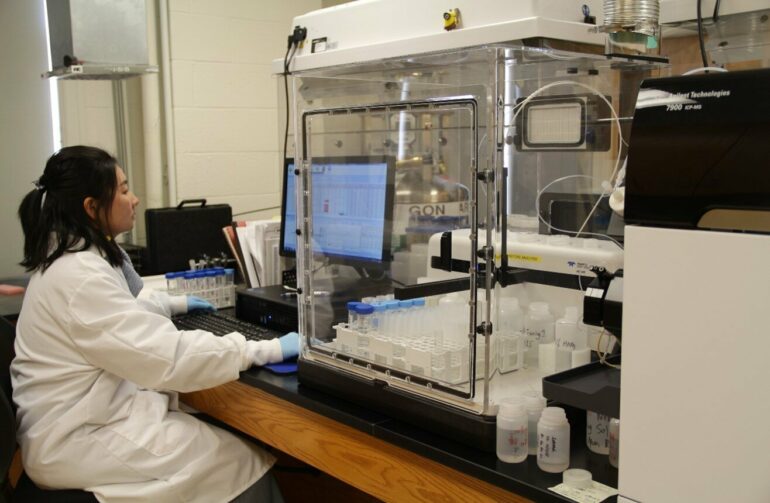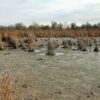Some 250 million years ago—long before dinosaurs roamed the earth—global warming and acid oceans caused by the rapid volcanic emission of the Siberian Traps led to the Permian-Triassic mass extinction, which resulted in the elimination of over 95% of marine and 70% of terrestrial life.
Then Mother Nature did what it does best—replenish herself. But why did it take her so long to do so?
That’s what an international team of researchers led by Professor Xiao-Ming Liu (University of North Carolina, Earth, Marine and Environmental Sciences), her Ph.D. student Cheng Cao (now postdoctoral fellow, Nanjing University) and her former postdoctoral scholar Clément P. Bataille (now Associate Professor, Earth and Environmental Sciences at the University of Ottawa), investigated over a six-year span. Their findings are published today in Nature Geoscience.
Where the understudy takes on a lead role
Their study demonstrates the incredible connection between life, climate, and Earth’s ability to replenish itself, along with the impact that the disappearance of a single organism (in this case, a single group of tiny marine organisms, the radiolarians) contributed to making the Earth almost un-habitable for millions of years.
Their main message is that every single organism on this planet plays a sometimes hidden yet critical role to regulate biogeochemical cycles, and that it should encourage us to lean into the conservation, and stewardship of our planet.
We sat down with professor Bataille to learn more about this study and its impact:
Professor Bataille, please explain what your big discovery was.
Clément Bataille: With this study, we propose a solution to explain the protracted recovery of life after the most severe mass extinction event, the Permian-Triassic mass extinction (The Permian extinction was caused by the massive volcanic eruption of the Siberian Traps and the associated warming and ocean acidification which eliminated over 95% of marine and 70% of terrestrial species.).
For decades, scientists have been puzzled by the absence of life recovery after this mass extinction, combined with the persistence of inhabitable environmental conditions on the planet. The typical regulation mechanisms observed after other mass extinction events, particularly chemical weathering, appeared to have been unsuccessful at returning Earth to more habitable conditions after the Permian-Triassic mass extinction. It took more than 5 million years after the end of massive Siberian Traps volcanism for life to recover in the Early Triassic. We demonstrate that this protracted recovery can be explained by an increase in reverse weathering in the ocean driven by the extinction of little microorganisms called radiolarians. This understudied mechanism would have maintained a hot greenhouse climate and acid oceans for millions of years, preventing life to recover. Only when those radiolarians reappeared after several million years was Earth able to return to habitable conditions and life to recover fully.
When and where did this research take place?
C.B.: This research took place between 2016 and 2022. Most analyses were conducted in Xiao-Ming Liu’s laboratory at the Department of Earth, Marine and Environmental Sciences, the University of North Carolina, between 2016 and 2019 by Cheng Cao and Clément P. Bataille. The modeling was performed by Cheng Cao between 2018 and 2020. The paper was written in several iterations between 2020 and 2021 by Cheng Cao, Clément P. Bataille, and Xiao-Ming Liu. The results were so surprising that it took us several years to properly defend our hypothesis.
What are your main findings? What is explained that we did not know or understand before?
C.B.: The Permian-Triassic mass extinction (251.9 million years ago), also colloquially named the Great Dying, is the largest known mass extinction event in the history of our planet. During this event, the majority of marine and terrestrial species disappeared in a short amount of time. This mass extinction event was triggered by massive volcanism, the Siberian Traps, which emitted gigantic amounts of greenhouse gases, increasing atmospheric carbon dioxide, elevating temperature, and acidifying oceans. However, unlike other mass extinction events where life recovered quickly and re-diversified, it took more than 5 million years for life to recover from this mass extinction. Marine and terrestrial conditions remained inhospitable for life with persistently hot temperatures, ocean acidification, and recurrent ocean anoxia for millions of years.
The persistence of these conditions puzzled scientists for years because the Siberian Traps’ volcanic activity stopped after a few hundreds of thousand years. Usually when emission stops, the Earth has a mechanism called chemical weathering that acts to regulate climate back to more habitable conditions. Chemical weathering encompasses all the reactions that alter rocks on the surface of Earth. As rocks are altered, they release some calcium, which when transported to the ocean can combine with carbon dioxide to form carbonates. With this mechanism, Earth regulates its climate, because when the planet warms, rocks weather faster, and more carbonate rocks are deposited in the ocean, ultimately decreasing atmospheric carbon dioxide and cooling the climate.
However, during the Early Triassic, despite evidences of increased chemical weathering, this mechanism failed to reduce atmospheric carbon dioxide, the climate remained very hot, and the oceans [remained] acid, preventing life from coming back. In this study, we managed to reconcile these contradictory observations to explain why environmental conditions remained uninhabitable for so long after the mass extinction almost leading to the disappearance of life on Earth.
And how was this research conducted?
C.B.: In this study, we used lithium isotopes in Permian and Early Triassic marine carbonates to reconstruct lithium isotopes in the ocean during that period. Isotopes are the different forms of an element that exist in nature and the proportion of these isotopes in substrates provides information about processes happening on Earth. Carbonate rocks precipitate directly from the ocean and could preserve the isotope composition of the ocean of the period during which they formed. Our initial idea when using lithium isotopes was to get some insights into the chemical weathering processes occurring on land during the Permian-Triassic period.
It is well-known that lithium isotope composition in the ocean responds to changes in chemical weathering on land because the isotopes are discriminated during chemical weathering reactions. However, when we analyzed lithium isotopes in those ancient carbonates, we discovered that the lithium isotope composition of the ocean decreased dramatically just before the extinction event and remained at extremely low values throughout the Early Triassic. We first verified that this signal was real by making sure we were recording the original isotope composition of the Permian-Triassic periods.
Once this was confirmed, we could not explain the very low lithium isotope composition observed in the ocean for this period by invoking only changes in terrestrial chemical weathering. Something else had to be at play. So we focused our attention on another, much less studied mechanism called reverse weathering, which we knew could have a large impact on marine lithium isotope composition. Reverse weathering occurs on the ocean floor and consists of the formation of marine clays by precipitation of silica and other cations dissolved in seawater.
However, for this reaction of reverse weathering to occur at a high rate, the ocean needs to have high concentrations of dissolved silica. In the modern ocean, the concentration of dissolved silica is very low because little organisms called silicifiers (diatoms) uptake almost all this silica to make their shells. These low concentrations of silica considerably limit reverse weathering reactions to occur on the ocean floor. However, we noticed that during the Late Permian, those little silicifier organisms went extinct. Once these organisms went extinct, dissolved silica in the ocean increase rapidly and nothing prevented the ocean from forming massive amounts of marine clays (i.e., increase rates of reverse weathering).
While reverse weathering reactions consume dissolved silica, they unfortunately also emit carbon dioxide. Therefore, as reverse weathering reactions increased so did the atmospheric carbon dioxide levels maintaining global warming and ocean acidification even after the Siberian Traps volcanoes stopped emitting carbon dioxide. As these little silicifiers did not recover until more than 5 million years after the Permian-Triassic mass extinction event, atmospheric carbon dioxide levels remained high, ocean acidification persisted, and environmental conditions remained largely inhabitable. Interestingly, this could have occurred even if the rate of chemical weathering on land was high, explaining the paradoxical observation of the high weathering rate and greenhouse climate of the Early Triassic. During the Early Triassic period, Earth failed to reduce the high atmospheric carbon dioxide levels because reverse weathering kept emitting large amounts of carbon dioxide.
Is there anything you’d like to add?
C.B.: This study demonstrates the incredible linkages and feedback between life, climate, and Earth’s habitability. It is amazing to think about how the disappearance of a single group of tiny marine organisms (radiolarians), contributed to making Earth almost uninhabitable for millions of years. It is a great lesson for our modern times. Humans are currently contributing to the sixth mass extinction. Among the disappearance of iconic species like large terrestrial mammals, hundreds of other unstudied species are disappearing. We should bear in mind that every single organism on this planet can play a hidden but critical role to regulate biogeochemical cycles. It should encourage every single one of us to act for conservation, and stewardship of our beautiful home.
More information:
Cheng Cao et al, Persistent late permian to early triassic warmth linked to enhanced reverse weathering, Nature Geoscience (2022). DOI: 10.1038/s41561-022-01009-x
Provided by
University of Ottawa
Citation:
New research demonstrates connection between climate and Earth’s ability to replenish itself (2022, October 3)



